INTRODUCTION
In irrigated crops from Ribatejo (center Portugal) - a floristic survey was carried out in potato fields from Golegã region, where 118 species of weeds belonging to 19 botanical families were identified. Annual species predominate (88%) over perennial species (12%). Six species stand out in decreasing order of importance in the fields: Datura stramonium L., Amaranthus retroflexus L., Calystegia sepium L., Sonchus tenerrimus L., Cyperus rotundus L. and Cyperus esculentus L.
The diversity, abundance and frequency of weed species reflected the intensity of cultural practices in each crop field. Specific richness ranged from 12 to 25 species per crop field. The total abundance in the least infested field was 6.5 plants per m2 and reached 128 plants per m2 in the most infested field (Calha et al., 2022).
Weeds are usually aggregated in patches within the crop (Wiles et al., 1992). This is important from the point of view of management because herbicide use could be reduced by spraying only patches with weed infestation or by adjusting herbicide rate. (Gerhards & Christensen, 2003; Barroso et al., 2004). In order to implement localized applications, it is necessary to know the spatial distribution map of the weed species. Due to the high cost associated with the generation of these maps is important to minimize the frequency of the mapping, therefore, the spatial and temporal stability of the weed patchs is critical. Species with a stable spatial distribution will not require the frequent generation of new maps (López-Granados, 2011).
The aim of this study was to assess the impact of mixtures of Poaceae and Fabaceae as cover crops on the structure of the floristic community of the maize crop, using geostatistical techniques and validate the remote results with in loco measurements of cover crop biomass in previous crop and weed abundance in cash crop.
MATERIAL AND METHODS
A field trial was carried in order to study alternative strategies to control main weeds from a potato (one year)-maize (two years) rotation, in Golegã, Ribatejo, Center Portugal (4380373N, 467433E). The field area of 2.5 ha was divided in three strips, 100 m long and 20 m width (Figure 1) with an experimental design of random blocks with three treatments, cover crop (CC): mixture Poaceae x Fabaceae; Tillage (Fs): soil tillage with harrow and a Control (T). Cover cropping density of sowing, date of sowing, harvest by cutting and shredding at date: Maize variety, density of sowing, date of seeding and of harvest. Weed control was conducted in postemergence with sulfonylureas. To evaluate the effect of treatments a sampling area of 1 m2 (with four replicates) was covered with PE film before herbicide treatment. Samples (seedlings plants m-2) were taken during maize twice per year, one at the beginning (before herbicide application) and at the end of the cropping season (one week before harvest). Sampling points were georeferenced.
The field trial was maintained during three years: 2018/2019 until 2020/2021. In the subsequent campaign similar procedure was followed for each treatment. NDVI were calculated from satellite images for the first year. The following years it was not possible to collect images. Remote detection of field plot during year 1 was carried out by analyzing satellite images taken at five different dates from October 2018 to March 2019. The same procedure was followed during maize copping cycle with satellite images taken at four dates (May to August 2019).
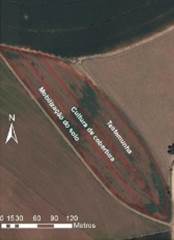
Figure 1 Experimental site, with indication of trial plot where the three treatments were implemented cover cropping, tillage and control.
At termination time cover cropping was cut at soil level with a blade linked to the tractor and shredded. Biomass at sampling areas of 1 m2 was collected for each treatment for dry weight assessment. During maize cropping cycle (15 days after herbicide application) weed abundance and diversity was assessed at ‘covered’ sampling areas.
RESULTS AND DISCUSSION
The NDVI allows to distinguish the vegetal coverage from bare soil, and could be an useful indicator of weed abundance in crop (Figure 2 and Figure 3).
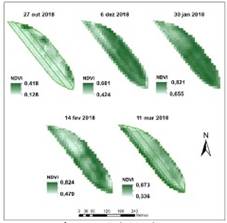
Figure 2 Normalized Difference Vegetation Index (NDVI) images collected over the experimental site (Sentinel satellite) on five different dates in the early season after cover cropping seeding during fall / winter 2019- year 1.
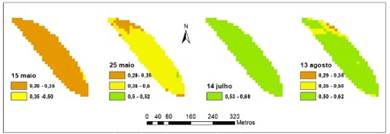
Figure 3 Normalized Difference Vegetation Index (NDVI) images collected over the maize field (Sentinel satellite) on four different dates after cash crop seeding during spring /summer 2019- year 1.
The NDVI could only distinguish between cover cropping treatment at the second date (27th October) - Figure 2. In cash crop, next season, it was not possible to correlate maize NDVI images with previous treatments (Figure 3). Although the biomass was significant different (Table 1).
Table 1 Biomass (dry weight) of three treatments in the experimental field (S. João Brito, Golegã) for three cropping cycles (2018/19; 2019/20; 2020/21)
| Years | Place | Treatments | ||
|---|---|---|---|---|
| Control (kg ha-1) | Tillage (kg ha-1) | Cover crop (kg ha-1) | ||
| 2018/2019 2019/2020 | S. João Brito | 4 264 ± 916* | 3 748 ± 172 | 7 815 ±1379 |
| S. João Brito | 3 702 ± 729 | 6 50 ± 2052 | 7 635 ± 2 196 | |
| 2020/2021 | S. João Brito | 2 393 ± 319 | 4 314 ± 897 | 4 598 ± 989 |
Cover crop biomass during fall was similar in year 1 and year 2 but decreased significantly to twice less in year 3. CC biomass in year 2 was twice of that of year 3. The results of soil coverage could explain the reduction in weed abundance compared to tillage and control in year 2 (Figure 4a). In year 3 the reduction of weed abundance compared to tillage was not significant, dure to lower biomass - Figure 4 (b). The diversity of weeds was also different in the two years (Figure 5).
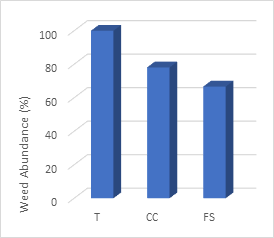

Figure 4 Weed abundance in maize crop after cover cropping during winter period (CC) compared to control (T) and tillage (FS) - year 1 (left) and year 2 (right).
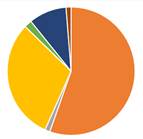




Figure 5 Diversity of weeds in maize following previous soil management practices: Control (T), Tillage (FS) and Cover cropping (CC, mixture Poaceae x Fabaceae): year 1 (a) and year 2 (b).
Biomass was higher in cover cropping compared to tillage and to control for the first two years. Year 3 represents a different situation where there was a reduction in cover cropping biomass as well as in the control. On the contrary tillage showed an increase in plant biomass. These results could be explained because 2020 was a much colder and rainy year compared to the previous (INE, 2021). The effect of cover cropping on weed abundance and diversity compared to tillage and control was analyzed in the next crop, maize. Weed abundance was higher in control, for both years, as expected. However the effect of cover cropping and tillage was different in each year.
In year 1 (S. João de Brito) there were significant differences between treatments compared to control (T). In next season main weeds from maize crop present in control plot Datura stramonium L. and Solanum nigrum L. were replaced by Hordeum vulgare L. in cover cropping plots which contribute to reduce weed abundance in 60% compared to control (Figure 5). Tillage also contributes to reduction of weed abundance but S. nigrum remains as the main weed species present. In the second year, the reduction on weed abundance by cover cropping (CC) and tillage (FS) was not evident - Figure 4. Cover cropping reduced S. nigrum similar to first year, but Echinochloa crus-galli had a high increment. The reduced effect on the second year could explained with lower biomass of cover crop (4 598 kg ha-1) compared to previous years 7 815 kg ha-1.
CONCLUSION
Datura stramonium, Solanum nigrum and Echinochola crus-galli were the main maize weeds found in the experimental site. Although the first two suffer a drastic decline in cover cropping compared to control, the results could not be confirmed in the second year at the same experimental site. Cover cropping was very effective in reducing weed abundance of the next crop compared to tillage. However the effect depends on cover crop biomass in the previous year and on weed diversity. Using NDVI to distinguish the vegetal coverage from bare soil, it was only possible to detect significant differences between treatments, by the middle of the maize crop cycle. At 1.5 months from harvest these differences were not significant, which can be attributed to the development of the crop, which attenuates the effect of weed competition. These results could be taken into account when planning site-specific treatments in maize.














